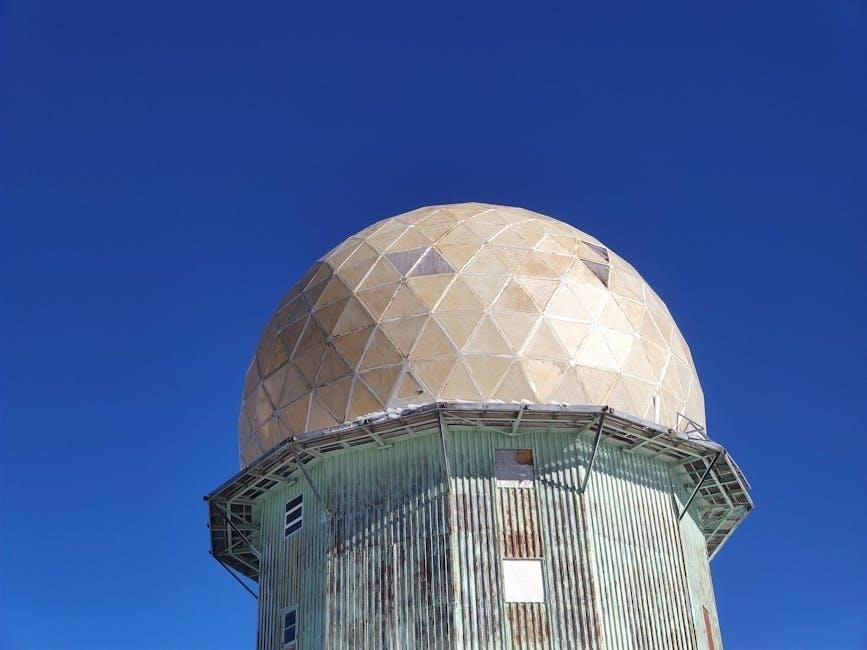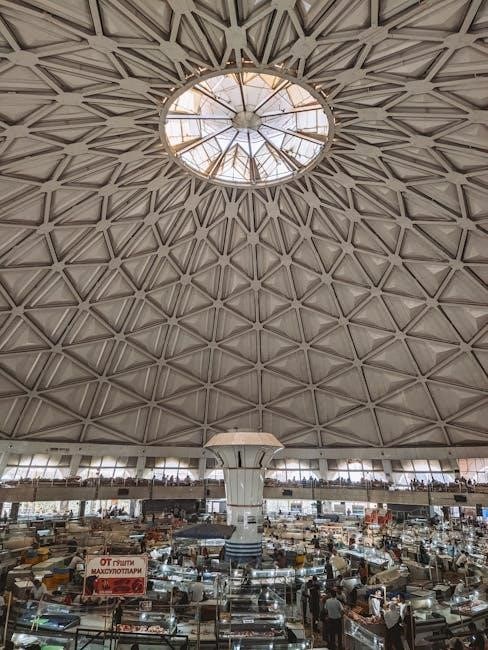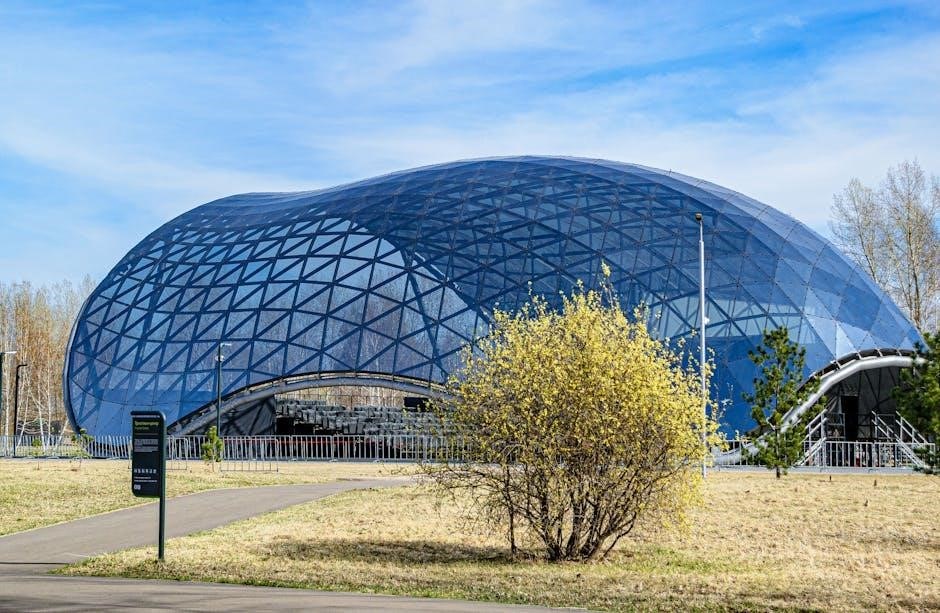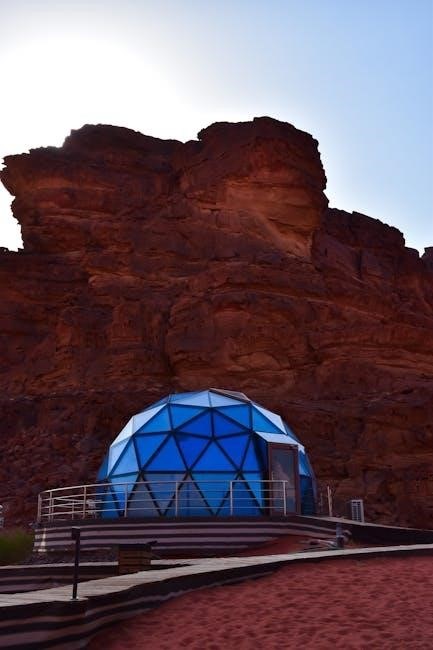Explore comprehensive guides for building geodesic domes with free PDF plans. Detailed designs, DIY tutorials, and material lists simplify construction for greenhouses, homes, and events.
Overview of Geodesic Domes
Geodesic domes are structures with a spherical shape, formed by interconnected triangles. Popular for their stability and efficiency, they are used as homes, greenhouses, and event spaces. Free PDF plans provide detailed frameworks, including materials and step-by-step instructions. These designs emphasize simplicity and scalability, making them accessible for DIY projects. The dome’s geometry ensures strength and minimal material use, offering eco-friendly and cost-effective solutions for various applications.
Importance of Detailed Plans
Detailed plans are crucial for successful geodesic dome construction. They provide precise measurements and step-by-step guides, ensuring structural integrity and efficiency. Free PDF plans often include lists of materials and tools, reducing guesswork and saving time. Clear instructions help avoid errors, making the process smoother for both novices and experienced builders. Without a well-structured plan, achieving the dome’s stability and desired shape becomes challenging, emphasizing the need for thorough documentation.
Benefits of Using Free PDF Plans
Free PDF plans offer numerous advantages for geodesic dome projects. They provide accessible, detailed designs and tutorials, enabling individuals to start building without financial barriers. These plans often include comprehensive material lists, step-by-step instructions, and scaling options, catering to various skill levels and project sizes. By utilizing free resources, enthusiasts can explore creative and functional applications, such as greenhouses or homes, while minimizing costs and maximizing efficiency in their construction journey.

Types of Geodesic Domes
Geodesic domes come in various forms, including DIY projects, greenhouses, and homes. These structures are versatile, offering practical solutions for shelter, gardening, and event spaces with unique geometry.
DIY Geodesic Dome Projects
DIY geodesic dome projects are perfect for enthusiasts seeking hands-on creativity. With free PDF plans available, these structures can be built using simple tools like PVC pipe cutters, drills, and bandsaws. Ideal for greenhouses, event spaces, or shelters, DIY domes are cost-effective and eco-friendly. Detailed guides ensure beginners can achieve professional results, making geodesic construction accessible and rewarding. Start your project today and explore geometric design possibilities.
Geodesic Dome Greenhouses
Geodesic dome greenhouses offer a unique and efficient way to grow plants year-round. Their spherical shape maximizes light distribution and space efficiency. Free PDF plans provide detailed instructions for constructing these eco-friendly structures, often using materials like PVC pipes and wood. Ideal for gardeners and sustainability enthusiasts, these domes are both functional and visually striking. With step-by-step guides and minimal tools required, building a geodesic greenhouse is an achievable and rewarding DIY project for any skill level.
Geodesic Dome Homes
Geodesic dome homes are increasingly popular for their space efficiency and eco-friendly design. Free PDF plans offer detailed blueprints for constructing these unique structures, ranging from small cottages to large family homes. With designs like double dome homes and single dome eucalyptus models, these plans cater to diverse needs. They often include floor plans, material lists, and step-by-step instructions, making it easier for DIY enthusiasts to build sustainable and energy-efficient homes. Expert-designed plans ensure structural integrity and aesthetic appeal.

Materials and Tools Required
Geodesic dome construction requires essential materials like PVC pipes, metal frames, or wood, along with tools such as saws, drills, and measuring tools for precision.
- Materials: Durable pipes, connectors, and covering materials.
- Tools: Saws, drills, measuring tapes, and wrenches for assembly.
Essential Materials for Dome Construction
Building a geodesic dome requires durable materials to ensure structural integrity. Common materials include PVC pipes, metal framing, or wood for the framework, and covering options like fabric, plastic, or metal panels. Additionally, connectors, screws, and adhesives are necessary for assembling the structure. For greenhouses, transparent materials like polycarbonate or glass are ideal. Ensure all materials are weather-resistant and suitable for your dome’s intended use, whether for a home, greenhouse, or event space.
- Framework: PVC pipes, metal, or wood.
- Covering: Fabric, plastic, polycarbonate, or glass.
- Fasteners: Connectors, screws, and adhesives.
Tools Needed for Building a Geodesic Dome
Constructing a geodesic dome requires specific tools for precision and efficiency. Essential tools include a bandsaw or circular saw for cutting materials, a drill press for accurate drilling, and PVC pipe cutters for framework assembly. A handheld drill can also be used, though it may slow progress. Measuring tools like a tape measure and level are crucial for ensuring accuracy. Additionally, wrenches, screwdrivers, and rivet guns may be needed, depending on the materials and connectors used in your design.
- PVC pipe cutters for framework construction.
- Bandsaw or circular saw for cutting materials.
- Drill press for precise hole drilling.
- Tape measure and level for accurate assembly.

Dome Sizing and Scaling
Scaling factors adjust dome dimensions while maintaining structural integrity. A 7055mm diameter is the largest recommended size. Most plans include detailed instructions for precise calculations to ensure stability.
Understanding Dome Sizes
Geodesic dome sizes vary widely, catering to different needs. Free PDF plans often include specifications for diameters like 35ft, 40ft, or 50ft, with detailed floor plans. These designs accommodate various purposes, from cozy homes to spacious greenhouses. The largest recommended size is typically 7055mm in diameter, ensuring structural integrity. Plans guide users in selecting the right size based on space requirements and intended use, making it easier to visualize and execute the project successfully.
Calculating Scaling Factors
Design Considerations
Ensure your geodesic dome design balances aesthetics and functionality. Free PDF plans offer detailed frameworks and stability calculations for a sturdy, visually appealing structure, ideal for various applications.
Framework and Structure Design
Free PDF plans provide detailed frameworks for geodesic domes, ensuring structural integrity. Designs include precise measurements and layouts, guiding you through the assembly of triangles and panels. Essential tools like PVC pipe cutters and drills are highlighted, with tutorials offering step-by-step instructions. These plans cater to various projects, from simple greenhouses to complex homes, making construction accessible for all skill levels. Start your project confidently with these comprehensive guides.
Triangle Calculations for Stability
Free PDF plans emphasize precise triangle calculations to ensure geodesic dome stability. Detailed formulas guide you in determining edge lengths and vertex angles, crucial for structural integrity. These calculations prevent errors and ensure the dome’s strength. Step-by-step instructions simplify complex geometry, making it accessible for DIY projects. With these plans, you can confidently construct a stable and durable geodesic dome, whether for a greenhouse, home, or event space.
Frequency and Dome Geometry
Free PDF plans highlight the importance of frequency in geodesic dome geometry. Frequency determines the number of triangles and their arrangement, impacting structural integrity and stability. Higher frequencies increase complexity but improve strength. Plans include frequency charts and calculations to ensure accurate construction. Understanding this relationship is key to achieving the desired dome shape and performance. These resources simplify the process, enabling builders to create efficient and durable geodesic structures for various applications.
Building the Geodesic Dome
Constructing a geodesic dome involves assembling triangular panels, attaching them to form the framework, and securing exterior materials. Free PDF plans guide each step for precision and durability.
Constructing the Framework
Constructing the framework is the foundation of building a geodesic dome. Begin by cutting and assembling the struts according to the PDF plans. Use drills and saws to precision-cut the materials, ensuring accurate angles and lengths. The framework’s stability relies on proper joint connections. Follow the step-by-step instructions to secure each strut, forming the dome’s base structure. Ensure all measurements align with the plans to maintain structural integrity and symmetry. This step is crucial for a sturdy dome.
Assembling the Triangular Panels
Assembling the triangular panels is a critical step in constructing a geodesic dome. Begin by cutting the triangular faces according to the PDF plans, ensuring precise measurements. Attach the panels to the framework using rivets or screws, aligning each edge carefully. Maintain structural integrity by following the plan’s sequence. Use a level to ensure even placement and secure each panel firmly. Proper alignment and tight connections are essential for the dome’s stability and durability. Follow the diagrams for accurate assembly.
Attaching the Exterior Panels
Attaching the exterior panels is the final step in enclosing your geodesic dome. Begin by aligning the panels with the framework, ensuring proper fit and coverage. Secure each panel using weather-resistant fasteners, following the PDF plan’s instructions. Apply a sealant to gaps for weatherproofing. Ensure panels are tightly fastened to withstand external forces. Double-check alignment and structural integrity before completing. Properly attached panels provide durability and protection, completing your dome’s exterior shell effectively.

Downloading Free PDF Plans
Access detailed geodesic dome blueprints via reliable websites. Free PDF plans offer easy-to-follow designs for DIY projects, greenhouses, and homes, ensuring a smooth building experience.
Where to Find Reliable Free Plans
Reliable free geodesic dome plans are available online through trusted websites like Natural Spaces Domes and Geo-dome. These sites offer detailed PDF designs for various projects, including greenhouses and homes. Additionally, online communities and forums often share user-created plans, ensuring accessibility for DIY enthusiasts. Always verify the source for accuracy and completeness to ensure successful construction. These resources provide cost-effective solutions for building your geodesic dome efficiently.
How to Choose the Right Plan
When selecting free geodesic dome plans, consider your project’s purpose, such as greenhouses, homes, or events. Evaluate the dome size, design complexity, and required skill level. Ensure the plan includes a detailed material list, step-by-step instructions, and clear diagrams. Choose plans that align with your tools and expertise. For beginners, start with simpler designs and scale up as you gain experience. Always verify the plan’s credibility and completeness before starting your project.

Tips for a Successful Build
Follow detailed plans, use tutorials for guidance, and start with small projects to gain experience. Ensure precise measurements and stay patient for a sturdy, accurate structure.
Importance of Precise Measurements
Precise measurements are crucial for a successful geodesic dome build. Even minor errors can disrupt the structure’s stability and geometric integrity. Use tools like calipers or laser levels to ensure accuracy. Double-check all calculations before cutting materials, as mistakes can lead to costly retries. Follow the PDF plans meticulously, especially for triangle dimensions and scaling factors. Attention to detail guarantees a durable, symmetrical dome. Invest time in measuring to avoid future complications and ensure a professional finish.
Using Tutorials and Guides
Utilizing tutorials and guides is essential for a smooth geodesic dome construction process. Video guides and step-by-step instructions simplify complex geometric calculations and assembly steps. Detailed PDF plans often include tutorials that cover framework assembly, panel attachment, and scaling adjustments. These resources help beginners and experienced builders alike avoid common mistakes. By following guides, you ensure structural integrity and accuracy, making the build more efficient and enjoyable. Tutorials are invaluable for mastering unique dome-building techniques and troubleshooting challenges.
Starting Small for Beginners
Starting small is a great way for beginners to gain experience with geodesic domes. Begin with a simple project, like a small greenhouse or a temporary shelter, using free PDF plans. These plans often include basic frameworks and material lists, making it easier to learn the fundamentals. Practicing with a smaller scale helps build confidence and understanding of the geometry and construction process. This approach minimizes risks and allows learners to refine their skills before tackling larger projects. Start small, learn, and progress effortlessly.

Real-Life Applications
Geodesic domes are used as homes, greenhouses, and event spaces. Their efficient design and versatility make them ideal for various purposes, supported by free PDF plans.
Geodesic Domes for Homes
Geodesic domes offer unique, eco-friendly living spaces. Plans for dome homes vary, with options like double domes (e.g., 45ft and 35ft diameter) offering 4636sqft of living space, including 5 bedrooms and 3 bathrooms. Single dome designs, such as a 50ft diameter dome, provide 3847sqft with modern layouts. These structures are energy-efficient and durable, making them ideal for sustainable living. Free PDF plans include detailed designs, material lists, and construction guides, enabling DIY enthusiasts to build their dream homes efficiently.
Geodesic Domes for Greenhouses
Geodesic domes are ideal for greenhouses due to their structural strength and ability to maximize interior space. Free PDF plans provide detailed instructions for building DIY geodesic greenhouses, including material lists and step-by-step guides. These designs emphasize natural light distribution and efficient climate control, perfect for growing plants year-round. Simple, cost-effective materials like PVC pipes and transparent panels are often used. Such plans cater to gardeners and growers, offering sustainable and durable solutions for cultivating plants in any environment.
Geodesic Domes for Events
Geodesic domes are increasingly popular for events due to their unique, futuristic appearance and versatility. Free PDF plans offer designs for temporary event structures, such as festival pavilions or exhibition spaces. These domes are easy to assemble and disassemble, making them ideal for short-term use. Their sturdy framework ensures durability in various weather conditions, while their open interior provides ample space for attendees. Such plans cater to event organizers seeking a visually striking and functional solution for hosting gatherings, conferences, or performances.

Tools and Resources
Easily access essential tools and resources for geodesic dome construction. Free PDF plans often include detailed material lists and tutorials for a successful build.
Essential Tools for Dome Construction
Building a geodesic dome requires specific tools for precision and efficiency. Essential tools include PVC pipe cutters, a bandsaw, and a drill press for cutting and assembling struts. A handheld drill can substitute for a drill press but will slow the process. Free PDF plans often provide detailed tool lists and tutorials, ensuring you’re well-prepared. These resources help streamline construction, making it accessible even for those new to dome building. Proper tools are crucial for achieving structural integrity and a professional finish.
Recommended Materials List
Free geodesic dome PDF plans often include a detailed materials list. Essential items typically include PVC pipes, connectors, and covering materials like plastic sheeting or metal panels. Additional components such as insulation, flooring, and doors may be needed for habitable structures. Some plans specify materials for specific projects, such as greenhouses or homes. Having a comprehensive list ensures you’re prepared and avoids mid-project delays. These resources are invaluable for both beginners and experienced builders aiming for a sturdy, functional dome.
Calculating Material Requirements
Precise material calculations are crucial for efficient dome construction. Use scaling factors based on your dome’s diameter and frequency to determine the exact quantities needed. Free PDF plans often include formulas or charts to simplify this process. Measure twice and calculate once to avoid waste. Consider the dome’s intended use, as greenhouses or homes may require additional materials. Consult specific plans for detailed requirements to ensure accuracy and prevent delays during assembly.

Safety and Legal Considerations
Ensure structural integrity by following plans carefully. Obtain necessary permits and adhere to local building codes. Avoid common mistakes that could compromise safety and legality.
Ensuring Structural Integrity
Structural integrity is crucial for geodesic domes. Use detailed plans with precise scaling factors to ensure stability. Adhere to engineering guidelines and verify geometry accuracy. Properly calculate material strength and connections. Regularly inspect the framework during construction. Avoid common mistakes like incorrect strut lengths or joint misalignments. Ensure all components are securely fastened. Consult professionals if unsure. Prioritize safety to withstand environmental stresses and maintain durability over time.
Obtaining Necessary Permits
Before constructing a geodesic dome, ensure compliance with local building codes and zoning laws. Obtain necessary permits to avoid legal issues. Submit detailed plans for approval, including structural integrity and material specifications. Permits may vary based on dome size, location, and intended use. Failure to comply can result in fines or removal of the structure. Always verify requirements with local authorities to ensure a smooth and lawful construction process.
Common Mistakes to Avoid
- Inaccurate scaling of dome plans can lead to structural instability.
- Neglecting precise measurements results in misaligned panels and weak joints.
- Ignoring detailed plans may cause costly material waste and rebuilds.
- Using incorrect tools, such as handheld drills instead of drill presses, slows progress and reduces accuracy.
- Skip consulting tutorials or guides, increasing the risk of errors during assembly.
With free PDF plans and proper guidance, building a geodesic dome is achievable. Start your project confidently, leveraging detailed designs and tutorials for a successful outcome.
Final Thoughts on Building a Geodesic Dome
Building a geodesic dome is a rewarding project, offering unique structural efficiency and aesthetic appeal. Free PDF plans provide detailed guidance, making it accessible for enthusiasts. Whether for a greenhouse, home, or event space, these designs ensure stability and functionality. Start small, follow tutorials, and utilize precise measurements for a successful build. With the right tools and materials, your geodesic dome project can become a reality, combining innovation with practicality.
Encouragement to Start Your Project
Embrace the creative challenge of building a geodesic dome with confidence! Free PDF plans offer a clear roadmap, making it easier to turn your vision into reality. Whether you’re a DIY enthusiast or a first-time builder, detailed guides and tutorials provide the support you need. Start small, experiment, and enjoy the process of creating a unique, eco-friendly structure. With patience and precision, your geodesic dome project can become a rewarding and inspiring achievement.

Additional Resources
Discover reliable websites offering free geodesic dome PDF plans, join online communities for support, and explore recommended books for in-depth guidance on your project.
Recommended Websites for Plans
Find the best resources for free geodesic dome PDF plans online. Websites like Geo-dome and Natural Spaces Domes offer detailed designs and tutorials. Pinterest provides inspiration and downloadable guides, while Instructables shares step-by-step DIY projects. These platforms cater to various skill levels, ensuring you find the perfect plan for your geodesic dome, whether for a greenhouse, home, or event. Explore these sites to kickstart your building journey with ease and confidence.
Online Communities for Support
Join online forums and social media groups dedicated to geodesic dome enthusiasts. These communities offer valuable resources, tutorials, and guides. Members share their experiences, providing insights and solutions to common challenges. Participate in discussions to troubleshoot issues and gain feedback. Such platforms foster collaboration and inspiration, helping you refine your project. Engaging with these groups ensures you stay informed and motivated throughout your building journey.
Books and Guides for Further Reading
Enhance your knowledge with detailed books and guides on geodesic dome construction. Titles like The Linchpin Writer and The Art of Project Management offer insights into planning and execution. Specific guides, such as those focusing on geodesic greenhouse designs, provide step-by-step instructions. These resources are invaluable for refining your skills and ensuring a successful build. Explore these materials to deepen your understanding and master the art of geodesic dome creation.
